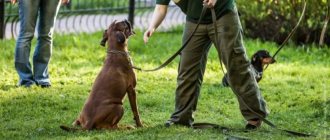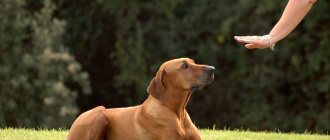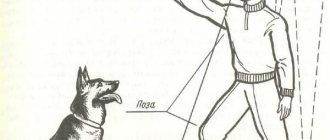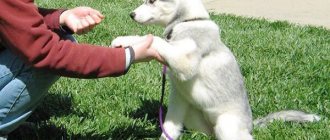It is not uncommon to encounter dogs that show aggression towards their owners when they approach a bowl of food or toys. This behavior means that the dog has a strong sense of ownership (which is in some ways a plus), and with proper training, such a pet will become a good protector of family members and home. But the threatening growl when the owner tries to take away treats or toys must be weaned off. And the best way to solve this problem is not with punishment, but with teaching the “Give” command.
On the command “Give,” the dog must give back the object he is holding in his teeth. Also, the order “Give” is used when a dog guards an object (toy, bowl, slipper) as its own property and does not allow anyone to approach it.
In OKD (general training course), “Give” is learned in conjunction with the “Fetch” command at the age of 6-8 months. But even if you don’t plan to get acquainted with fetch, you need to teach the puppy the “Give” command in any case. Training should begin at 2-3 months, when the puppy is already accustomed to his new home and playing with you.
The meaning of the command “Give me your paw!” for dogs
The command to the dog “Give me a paw!” is an important skill that will come in handy when caring. For example:
- will help you quickly wash your paws after a walk;
- trim or file the dog's nails;
- comb the wool;
- check the paws for ticks and cuts;
- treat the pads if damaged;
- put shoes on your paws.
Team training develops intelligence and teaches teamwork. Helps to establish and strengthen psychological contact between the owner and the dog.
The dog's habit of giving his paw helps him learn other interesting tricks.
And simply pleases family members with a friendly gesture,
Teaching a dog the command “Give me your paw!”: Photo
When should you start teaching your dog the “Give me your paw!” command?
The command “Give me your paw!” has no lower age limit. Most often, they begin to practice it from 3 months. From the moment the puppy arrives in its new home. It's easy to learn. Because the puppy massages the mother's belly from birth. This innate instinct is called the “milk step.” It allows the baby to extract more milk from the mother's nipples. This is how the puppy’s conditioned reflex is reinforced. The movement of the paws leads to pleasure. Therefore, kids learn the command “Give me your paw!” in 5-7 days. And they get only pleasant emotions from classes. By following a command, the puppy feels friendly, praise, and approval. These sensations contribute to the formation of emotional contact with the owner.
In parallel with the command “Give me your paw!” learn the commands “Sit!”, “Lie down!” and “Stop!”
The dog command “Give me a paw!”: training technique
For training you will need pieces of treats. For example, your favorite food, cubes of cheese or boiled chicken. You can take dog biscuits. Do not take large pieces of treats for training so that the dog does not get full ahead of time. Choose a treat that won't crumble. Otherwise, the puppy will be distracted by crumbs and learn the task less well.
It is best to train 1.5-2 hours after feeding. The dog should be neither full nor too hungry. Then the dog will be more interested in receiving the reward. She will try to take the initiative. The dog must have contact with you and the desire to interact. Gradually reduce treat rewards. Accustom your puppy to vocal approval: “Yes! Fine!" and stroking.
- Have the dog sit in front of you.
- Take a treat in your hand and let your dog smell it.
- Then squeeze the food into your fist, keeping your hand at the level of your pet's chest. The dog pokes its nose into the fist and tries to get the pieces out with its teeth. Don't rush to help her. The moment will come when she starts touching your hand with her paw.
- Say the command “Give me your paw!” and open your palm. Let your dog eat this treat and praise him: “Yes! Fine!".
- During class, repeat this exercise 3-5 times. The dog always quickly understands the essence of the task: touch the hand with its paw to get food.
The command to the dog “Give me a paw!”: the first stage of training. Photo
Do not confuse: “Give”, “Throw” and “Fu”
To begin with, it is important to understand how this command differs from “Drop” and “Fu”. They also involve releasing an object from the teeth, but with one “BUT” - strictly on the ground, and not in the hands of the owner.
“Throw” and “Fu” differ from each other only from a formal point of view: the first can be used strictly in everyday life, and the second can be used at dog shows and other official events.
IMPORTANT!
“Fu” is included in all obedience courses and serves to indicate a total ban. You can read more about unlearning here.
Teaching the dog the command “Give me your paw!”: the second method
If your dog isn't eager to get the treat, try another method.
- Have the dog sit in front of you.
- Give her food in your palm.
- She will start eating it. And you slowly move your hand to the side. The dog will automatically shift its body weight to one paw. And he will lift the second one.
- Then you say: “Give me your paw!”, take it by the paw and praise: “Yes! Fine!". And give him a treat.
- Then repeat the exercise on the other side. When your pet raises its paw, praise it and give it a treat.
If the dog rises to its feet after giving a paw, you need to sit it down without rewarding it with a treat. And repeat the task.
Beginning of teaching a dog the command “Give me your paw!”: Photo
What is needed for training
For the initial stage of training, it is most convenient to use a wooden or rubber stick, a piece of rope or rope 40-50 cm long. This length is necessary so that the trainer can take the object being retrieved by one end, and the dog by the other, without interfering with each other and not causing damage. injuries. The diameter of the stick must be selected so that the thing fits in the pet’s mouth and does not cause him discomfort.
Requirements for items that are most often used for training:
- The item to be imported should not emit any strong odors and be without chemical treatment or coloring. These factors can negatively affect the health and well-being of the animal.
- To reinforce the skill, rubber balls, wooden dumbbells and other safe objects that can be placed in the animal’s mouth can be used.
- The equipment for executing the command should not be iron objects, toys, or food.
- You cannot undergo training with things covered with long fur, lint and feathers. In this case, the dogs feel uncomfortable.
How to teach a dog the command “Give me your paw” if he doesn’t want to pick it up on his own?
Sometimes the puppy doesn’t want to get the treat with his paw. Trying to get to him with his teeth. In this case, try rote learning.
Say: “Give me your paw!”, take the puppy by the paw and help him reach your hand. It’s better not to pull his paw, but just push him with light tickling movements.
Give him the treat and repeat the exercise again.
Praise when the dog has just made an attempt to lift his paw off the floor. Don't wait for her to lift it all the way.
The baby will quickly understand how to get the treat and begin to lift his paw on his own.
You can lightly pat his paw at first, gradually reducing your interference. When your pet raises its paw, give the treat. And joyfully praise him: “Yes! Fine!".
Positive reinforcement in learning: Photo
The command “Give me your paw!” for dogs: recommendations from dog handlers
- The “Leader of the Pack” should conduct the training. Then the puppy will try even harder to please the leader.
- Conduct your training in a quiet place. If you study at home, turn off the TV. Move pets to another room. Remove toys that distract your dog. You can also practice outside. On a playground without distractions (other dogs, people, cars).
- Conduct your workout in a good mood.
- The workout should last no more than 5-10 minutes. And between exercises, give your puppy time to rest. Games will help replace mental stress with physical stress. They will cheer you up and help you avoid overwork.
- Classes must be systematic.
- You can use a clicker for training. In this case, click it as soon as the dog lifts its paw off the floor.
- Don't scold your dog for trying to get food with his teeth. Use only positive reinforcement for desired actions. Avoid any manifestations of irritation and anger. Only positive emotions!
- Do not repeat the command several times. If the dog does not follow the command immediately, it means that it does not understand it yet. Continue to prompt her with a task using your fist with a treat.
- Training should evoke only positive emotions in the dog. Then mastering the task will be much easier.
Nuances and features
During the training process, be sure to take into account your pet’s mood. Skip a planned workout if your dog looks sick or just tired. Your own well-being is equally important. Remember that 10 minutes of exercise three times a day is more than enough.
IMPORTANT!
When learning to give an object, the reward is its return and praise. This distinguishes it from “Fu”, where what is spat out remains strictly on the ground.
Don’t rush to embrace the immensity and move smoothly from simple to complex. If problems arise, be sure to return to the previous step.
The command to the dog “Give me a paw!”: practicing variations
When the dog learns to quickly give his paw on command, move on to the next stage.
Enter the additional command “Give me another!” so that the dog gives the right and then the left paw alternately. Then move on to learning to move your hind legs. Conduct classes according to the same principle.
Each owner can choose the options for additional commands that will be convenient for him. For example, you can teach your dog to present a certain paw by numbering them clockwise: 1-2-3-4. And the dog will give the paw that the owner needs. You say: “One!”, and the dog gives his front left paw. Say: “Two!”, the dog gives the front right paw. Etc.
How to teach a dog to give his hind leg: Photo
Sometimes the owner is more comfortable with another option. For example, you give the dog your right palm, the dog accordingly gives you his left paw. When the dog sees that you are giving your left hand, it raises its right paw.
So there are plenty of variations. Choose ones that are comfortable for you for your dog. And work it out, constantly rewarding with treats.
Whatever command you choose, use only it all the time. Both you and everyone in the family should use the same commands to avoid confusing your dog.
Don't talk to your dog in long sentences. For example: “Please give me your right paw!” The dog understands short, clear commands better.
How to teach a dog to give away different objects
To make mastering the skill easier, try a step-by-step training scheme. Four-legged pets find it easiest to practice with toys, since it can be translated into regular play.
Toys
First, you should find something valuable to exchange: a second toy or treat. Having dealt with the reward, proceed to working out:
- Throw the ball and command “Give” immediately after the dog picks it up.
- Reach under the ball with your free hand and use your other hand to attract your pet's attention.
- Praise the animal if it spits the ball directly into your hand and give it a reward. Please note that food rewards are used only in the very first stage.
- Don’t forget to return the taken ball by commanding “Take.” Otherwise, the dog will decide that “giving away the toy” means “losing it forever.”
Repeat the exercise until you get the desired result. If the animal persistently ignores your hand and simply lets the ball fall to the floor, then try to catch it yourself. Ultimately, your pet will understand that it is necessary to give it into your hands.
ADVICE!
If you plan to take the OKD, then you should use a dumbbell instead of a toy.
I'm on my way
The next stage involves practicing with a treat. With the basics in place, your pet won't have to worry about sharing food because he knows it won't be taken away forever.
An even greater complication is taking away the food bowl while eating. This exercise makes the animals very nervous, so it is best to practice it at the end of the meal, when there is practically nothing left in the feeder:
- Say the command "Give" to get your dog's attention, then gently lift his head off the bowl by placing your hand under his throat.
- Take the bowl away for a couple of seconds, then return it, command “Okay” and praise your pet.
Repeat the described actions at each feeding until automaticity appears: independently raising the head after receiving an order. Be sure to praise your pet if he does not show aggression.
If for some reason the bowl of food cannot be returned, then the usual reward (its return) needs to be replaced with something. The easiest option is to distract yourself with a game or toy.
Selected items
At the third stage, the skill is complicated by combining it with the order “Take”. Your slipper or newspaper will be suitable for practicing:
- Attract your pet's attention, place the item on the floor and say “Take.” If the puppy does not react, point to the slipper or newspaper with your hand.
- Command “Give” immediately after picking up the item and put your hands up.
Do not try to take away an item if the puppy does not give it back. Instead, try doing the same thing, but by playing tug of war.
Complicating the command
At the last stage, the execution of the command can be complicated by various stimuli: the presence of other people and animals or the noise of cars. To do this you will have to go outside.
Another possible complication is distance, that is, a connection with the “Aport” command. Change the distance of throwing the ball gradually so as not to cause rejection by the need to be active.
The command to the dog “Give me a paw!”: further development
Then practice with your dog following the command from different positions. For example, after the commands “Sit!” , "Lie!" or “Stop!”
There are dogs that quickly learn to give a paw from a standing position. And there are those who try to sit down first. Help her by holding her tummy. And make it clear what you want. Say: “Stop! Give me your paw!”
Giving the paw in a lying position is the most difficult. The puppy's muscles quickly get tired from unusual loads. Therefore, do not do such exercises more than 1-2 times per lesson.
Also teach the puppy to give his paw regardless of your position. Not only when you sit in front of it, but also when you stand or lie down.
Gradually encourage your dog to hold his paw in the air for a few seconds. Only after this give the treat.
Once your dog learns to follow the command, continue to practice it in areas with distractions (other animals, people, cars).
Dog gives back paw on command: Photo
Team Dai: basic training rules
The trainer influences the pet in many ways: gestures, clothing, voice, nature of movements, facial expressions. This person also becomes a strong irritant for the dog. It is necessary to establish the correct relationship between the pet and the trainer, so that the dog always carefully observes the movements of the person, trusts him, obeys at the first command, Dai, is completely obedient and is not at all afraid. Gestures and movements are an important part of the training process. For example, fast and jerky movements can cause a defensive reaction in the animal, after which the dog will become timid or even cowardly at the sight of the trainer. Conducting and organizing training requires taking into account many important points:
- know the dog’s character and behavioral characteristics;
- carefully develop the acquired reflex, without departing from the training program;
- set clear goals before each lesson;
- do not change gestures, signals and words of commands, always give them clearly and equally. You can choose different intonation when the dog behaves inappropriately;
- be sure to encourage correct action;
- try to add variety to the training process, while observing the dog’s interest in the work;
- help the animal with signals and gestures, to understand what is required of it in order to carry out commands as accurately as possible. Encourage in a timely manner;
- draw a clear line between the free and working state of the dog. At the same time, the trainer must also behave differently: during classes, have an important appearance and a corresponding tone of commands - persistent, commanding, demanding. In your free time, you need to let the dog frolic and play with it.
Constant and monotonous execution of commands (including the “Give” command) will develop a stereotype in the dog. For example, putting the dog down and landing is trained first, jumping over hurdles will be the second stage, and giving the voice at the very end. Repetitions should take place in the same order to quickly and successfully consolidate skills. Just a couple of lessons and the dog will remember the first command “sit!” The animal will continue to execute the remaining commands without a command, in the same sequence. The same place and time of training will develop a conditioned connection in the dog - here you need to work, not play. If the trainer is constantly wearing a training suit, the pet gets used to reacting to a person in this form.
Why does the puppy give his paw without a command?
You started practicing the command, and the puppy quickly understands: you need to raise your paw and get food. Therefore, the dog often gives its paw without a command. Especially if you are happy about it and encourage her. This is how the dog tries to earn a treat. Sometimes he insistently demands it from you. Don't pay any attention to it. Reward your dog only when he raises his paw at your command. Do not forbid the puppy to raise its paw without a command. Just “don't notice” it. A clear algorithm must always be followed: TEAM - ACTION - INCENTIVE. Gradually, the pet will understand and get used to the fact that the treat will only be given after the command “Give me your paw!”
“Bring it”: working on mistakes.
For dogs, this command means a fun game of searching for an object. A common mistake when learning a command is to rudely yank the thing out of the puppy's mouth. The dog will simply think that the owner is punishing him for something, and will no longer take this object.
You need to teach the command affectionately, rewarding the dog for every correct action with praise, stroking and treats.
As your pet ages, it begins to recognize the names of many things in the house. This happens to those dogs with whom the owners communicate a lot. Highly intelligent animals are able not only to understand human intonation, but also to distinguish certain words for themselves, associating them with real things. When learning the “Fetch” command, it is worth taking advantage of this property of the dog’s brain.
The command to the dog “Give me a paw!”: how to understand that it has been worked out?
The command “Give me your paw!” is considered mastered if the dog:
- performs it no later than 2-3 s after submission;
- does it from any position (sitting, lying, standing);
- puts the paw on a support or holds it in weight;
- performs without reward with a treat;
Watch a video on how to teach your dog the command “Give me your paw!”
The command to the dog “Give me a paw!” in various ways helps develop thinking and initiative. You make your classes more fun and interesting. Teach your dog to communicate with you and trust you. This is how love and friendship gradually develops between owner and pet. Just don’t forget that you need to repeat the skill regularly so that your pet doesn’t forget it. Kids receive new information every day. What is not processed is quickly forgotten.
Clicker for dogs
By the way, in order for such behavior to become a habit of the animal as soon as possible, before delivering a speech of praise, you can use a special device - a clicker for dogs. The device, created specifically for training, received such an unusual name because of the sound it produces - a characteristic click or, simply put, a “click”. The fundamental principle of its work is to reward behavior at the moment of doing the right thing. Thus, the dog’s owner gives a timely signal using a clicker, and his faithful four-legged friend clearly understands why he receives praise. This device allows animals and people to understand each other without words.
Clicker for training











